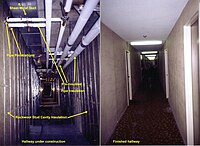
Photo from wikipedia
Abstract This paper summarizes the main findings for evaluating the effectiveness of simplified and advanced control strategies to operate switchable insulation systems applied to the attic of US residential buildings.… Click to show full abstract
Abstract This paper summarizes the main findings for evaluating the effectiveness of simplified and advanced control strategies to operate switchable insulation systems applied to the attic of US residential buildings. Specifically, the evaluation analysis is performed for five US representative climates to determine the performance of several control options for dynamic insulation systems to minimize the heating and cooling energy end-uses for US homes. The control strategies considered include scheduled settings, temperature-based rule sets, and optimal control schemes. The comparative analysis results clearly indicate that the switchable insulation systems even when only applied to attics have significant potentials in reducing the cooling energy use of US residential homes especially those located in mild climates. Even when operated with simplified controls such as time-scheduled controls and temperature-based rule-sets, dynamic insulations are capable of providing substantial energy savings. In particular, controls using rules based on mean air and sol-air temperatures result in cooling energy savings ranging from 8% to 43% for all US climates. When optimal controls are used to operate attic dynamic insulation systems, up to 40% additional savings in cooling energy can be achieved compared to the best simplified controls at least when the building is located in Golden, CO.
Journal Title: Energy and Buildings
Year Published: 2021
Link to full text (if available)
Share on Social Media: Sign Up to like & get
recommendations!